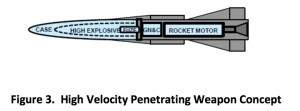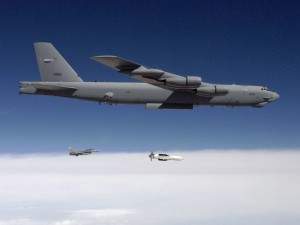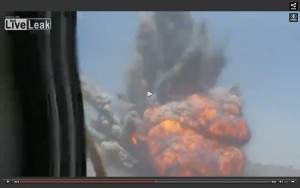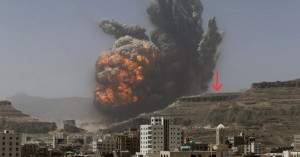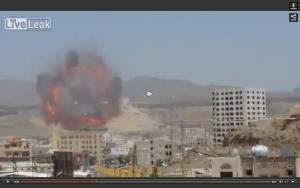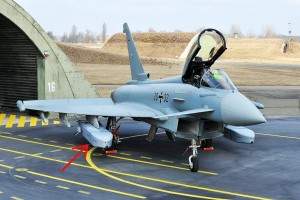Israelis confirm existence of high velocity penetrating weapon
December 1, 2023 by Thomas Wictor
On April 20, 2015, there was a gigantic explosion at the Faj Attan missile base in Sanaa, Yemen. I knew immediately that this was a new weapon. On November 26, 2015, the Israelis confirmed that I was right. This device is called the high velocity penetrating weapon (HVPW). It’s a hypersonic, rocket-powered bunker buster that uses both kinetic energy and a new form of explosive in order to destroy targets deep underground or on the surface.
In the US, the weapon was conceived in about 2010. Raw explosive power can only penetrate so deep. There’s a limit to the size of a bunker buster, simply because they get too heavy for an aircraft to carry. Currently the largest bunker buster is the American GBU-57 A/B Massive Ordnance Penetrator (MOP).
The US Air Force has…twenty of them.
Just to refresh your memory, here’s the explosion at Faj Attan.
We can determine from the delay between the explosion and the sound that the cameraman was 1.5 miles (2.4 kilometers) from the target. Even at that distance, the shock wave broke his camera.
As you can see in the above screen grab, the energy released by the HVPW distorted the image. Since it was a digital camera, the video was on a memory card, which allowed the footage to survive.
I calculated that the debris towers and fireball reached a terminal height of at least 2000 feet (610 meters).
This is a rough estimate, based on the fact that the wall around the missile base (red arrow) is ten feet (three meters) tall.
Other than a tactical nuclear device, there was no known weapon that could’ve caused this explosion and shock wave. I knew that it wasn’t a storage depot of SCUD missiles going up, because there are no secondary explosions. If that was a storage facility for solid or liquid-fuel rockets, the explosion caused them to all detonate simultaneously, which is impossible.
Here you see an attack on a munitions depot in Libya.
Note all the little comets flying around. Those are missiles. The large fireballs dwarf the initial black cloud, due to the fact that rocket and missile fuel was being consumed faster than the smoke could rise.
There are six different bulges in the fireball, meaning that these are secondary explosions.
The explosion at Faj Attan in Yemen was one fireball, and the debris towers were taller than the flames.
A screen grab shows that the smoke, fireball, and debris emerged from the ground simultaneously.
In other words, it was one event. A single munition created all that chaos, as well as the most powerful shock wave I’ve ever seen. It made the debris travel faster than the fireball could rise. I’m guessing that the HVPW is a thermobaric explosive, also called a fuel-air explosive. Some form of liquid is vaporized, mixed with atmospheric air, and then set off by another detonation. Thermobaric explosives create gigantic shock waves.
So how have the Israelis confirmed the existence of the HVPW?
A senior official in the technical division of the [Israeli air Force] explained that the force’s abilities have grown to the point that it currently is able to rapidly unleash 3,000 missiles weighing one ton each - “very smart missiles” according to his definition.
He explained that within four days of fighting, a barrage of that sort would be enough to topple a state.
“We are talking about a missile installed on a F-15 or F-16 that is fired from a height of 30,000 feet,” said the official. “The moment the pilot fires the missile it is able to go exactly to the target and destroy it.”
First, an air force officer would never call a bomb a missile. Therefore this is a powered munition, not a free-fall bomb. The officer said that the missile would be fired, not dropped. So again, it’s not a bomb.
Any powered munition fired from an aircraft at a target on the earth is called an air-to-surface or air-to-ground missile. There aren’t any that weigh 2000 pounds (946 kilos). The Germans have the Taurus KEPD 350, which is actually an air-launched cruise missile. Some people call it an air-to-surface missile, so for the sake of argument, let’s say it is.
“KEPD” stands for “kinetic energy penetration destroyer,” which sounds similar to the HVPW in concept. However, the KEPD 350 is subsonic. It can’t fly faster than the speed of sound, topping out at Mach .95. The HVPW is hypersonic, meaning Mach 5 and above.
To accomplish its task of penetrating, the KEPD 350 uses a double warhead that contains 1100 pounds (500 kilos) of explosive. The largest bomb that Israel has in terms of explosive power is the American MK-84, which weighs 2000 pounds (946 kg), of which 945 lb (428.6 kg) is Tritonal high explosive.
Obviously the KEPD 350 isn’t designed to topple a state; the Germans built only 600 of them. It’s a tactical rather than a strategic weapon. Numbers of tactical munitions don’t matter. During Desert Storm, the US dropped 12,000 one-ton MK-84 bombs on the Iraqi armed forces, but it didn’t topple Saddam Hussein.
So the Israelis say that 3000 of their one-ton missiles over four days will topple a state. That means it has to be the HVPW. There’s no other answer. No known one-ton non-nuclear munition could destroy a government. This is a new strategic weapon.
On May 21, 2015, the US approved an arms sales to Israel worth $1.9 billion. It included joint direct attack munition (JDAM) tail kits for 10,000 one-ton MK-84 bombs. Here’s what the Pentagon’s Defense Security Cooperation Agency said.
The proposed sale of these munitions will not alter the basic military balance in the region.
If 10,000 one-ton bombs wouldn’t alter the basic military balance in the region, then how could 3000 topple a state? Therefore the Israelis have just confirmed the existence of the HVPW. It’s the weapon’s unprecedented shock wave that does the damage. I’m sure that the HVPW has different fuses so that it can explode above, on, or under the ground.
And by “topple a state,” the Israelis mean destroy its offensive capabilities. I’d hate to be a Basij right now. They’re the bastards who keep the Iranians oppressed.
And here’s some more news. An employee of Bombardier has confirmed that an Israeli-owned company is having a certain type of aircraft converted for the United Arab Emirates. Since neither the Israelis nor the UAE have said anything about this, I won’t reveal the aircraft. The Bombardier employee didn’t know what the conversion was, except that some of the work was being done in the UK.
It’s a strategic bomber. If the Israeli-Arab HVPW weighs one ton, this aircraft could carry about 70 of them. The Israelis say they have the capability of firing 3000 HVPWs over four days, using multirole jet fighters, small aircraft with one or two crew members. Therefore the UAE will be able to deliver about 15,000 HVPWs in the same period. And I was right. The configuration is nearly identical to that of the 747-200F ALCM Carrier.
“ALCM” stands for “air-launched cruise missile.” The US Air Force conceived of this conversion but never went ahead with it.
Israelis and Emiratis built it instead, using a different, better aircraft.
Where I live in Southern California, we often hear very odd sonic booms. The usual sonic boom is a single detonation.
What we hear is ba-ba-ba-ba-ba-bap. The windows shake, and sometimes you can feel it in your feet. I thought it was an American secret project, but now I believe that it was Israeli-Arab. My brother Tim says it’s a scramjet (supersonic combusting ramjet). If so, the missile would have a projected speed between Mach 12 (8,400 mph; 14,000 km/h) and Mach 24 (16,000 mph; 25,000 km/h).
That’ll leave a mark.
This article viewed 1916 times.

